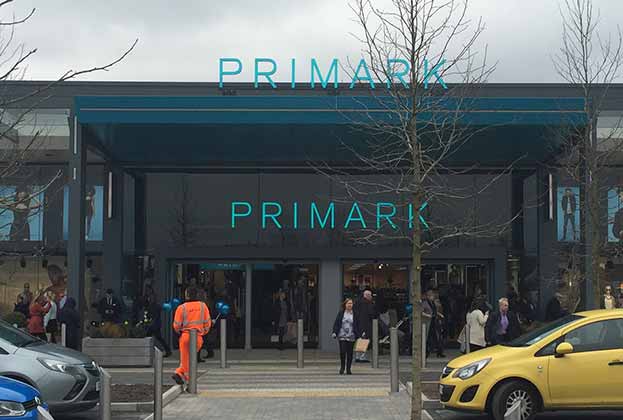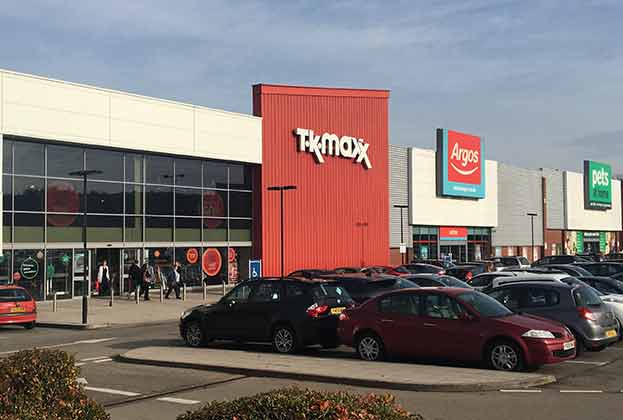Retail warehousing shows signs of resilience amid the pandemic after a strong start to the year for new lettings and a marginal return to rental growth
2019 was a record year in terms of rends for Savills schemes the number of new openings in the retail warehousing sector. 1,021 units were let, well above the decade average of 854. Taking closures into account, by year end the sector had an additional 479 stores than it had 12 months prior.
Value orientated retail led the way in terms of acquisitions, accounting for just under half or all activity. Aldi, Lidl, Iceland, B&M, The Range and Home Bargains accounted for as much as 44% of new space in the market.
61% of the floorspace in the retail warehousing market was designated as essential
Savills Research
Despite the record number of lettings the total additional floorspace in the sector accounted for no more than the decade average at 10.4m sq ft in 2019, with a preference for units of between 10,000 and 20,000 sq ft for the majority of the sectors most acquisitive brands.
A structural change with regard to rents was the driving force behind the acquisition activity. With much of the market considered to be over-rented the balance of power in most negotiations remained in favour of the retailer, leaving both landlords and potential investors wondering where the bottom was in terms of rental decline.
Value orientated brands were particularly opportunistic, looking to expand their operations or renegotiate existing leases and take advantage of falling rents. The chart below highlights how the schemes Savills have been involved with have seen a 22.7% decrease in rents since 2017, falling from an average of £28 psf to £22 psf at by the end of 2019.
This is turn had a knock on effect when it came to vacancy in the market. Comparatively low compared to other sectors, vacancy was at a healthy 4.9% by December last year as retailers looked to snap up the supply of retail warehousing on more favourable terms.
At the start of this year the pertinent question therefore became what, if anything, would change in the out of town supply and demand cycle. It was our view at the end of 2019 that the low vacancy position in the market would begin to help reduce the rental encumbrance, without necessarily eliminating it all together. Indeed by the end of Q1 vacancy in the market has remained low, creeping up by only the smallest of margins to 5.0%, however it seems the slide in rental income has, at the very least, begun to plateau. Analysis on the deals Savills have been involved in, have returned to positive territory for the first time since 2017 with a 1.7% growth on the average headline rents reported the previous year (see above chart).
Before the true onset of Covid-19 and a global pandemic, and despite what an optimistic analyst might describe as the very early shoots of a recovery in terms of rental growth, lease terms still remained attractive in the first quarter and plenty of retail and leisure operators continued to be very active in the market, with the usual suspects leading the charge.
302 stores were let in Q1 with value orientated retailers again at the front of the pack. The tables below highlights the top 10 acquisitive retailers in terms of both units and square footage with Aldi, Lidl, Iceland, B&M, The Range and Home Bargains accounting for as much as 47% of activity in terms of additional retail warehousing space. Having already achieved just under a third of last year’s record total by the end of Q1, retail agents could be forgiven for getting excited over the prospect of another bumper year in terms of operator lettings, the strong pattern of acquisition activity showing no signs of slowing down.
However, as we approached the end of Q1 the elephant in the room was growing increasingly larger. Like every other facet of our lives the retail warehouse market has not been immune to the impact of coronavirus. The question now becomes what effect will the pandemic have on the pattern of activity we have been witnessing over the last 18 months?
With many retailers unable to trade from physical stores for many weeks and a decreased trading efficiency as they begin to re-open their stores, will we see a number of business fail and fall out of the market altogether? Will we see additional rental decline on top of what we have witnessed in the last few years as retailers profit margins continue to suffer with the disruption in trade? Will this put an end to the strong acquisition activity we have been witnessing and lead to a rise in vacancy in the market?
Of course, while we are in the eye of the storm it is impossible to answer all of those questions with any degree of certainty. However, looking at the data we do have on the initial impact of Covid-19 on the retail and leisure market, for retail warehousing there has been at least some positives of note from what undoubtedly has been one of the most significant changes within the UK retail market in living memory.
Firstly, despite the widespread retail and leisure closures, the out of town market displayed some level of resilience with a quarter of all UK retail floorspace remaining open via the out of town market after the government imposed sanctions came into play at the end of March (see below). In the week following the beginning of the lockdown restrictions, 73% of all retail and leisure operators were classified as ‘non-essential’ with only 27% of the market being eligible to stay open. However, of the retail floorspace that was eligible to stay open, the out of town market accounted for more than half at 54%, in comparison with the high street, shopping centres and individual shops (as shown below).
Furthermore, as much as 61% of the floorspace in the retail warehousing market was designated as essential due to large supermarkets and DIY stores accounting for a significant proportion of the sector. In comparison, high streets have seen just 37% of the floorspace considered essential, with shopping centres seeing only 25% (see below).
As restrictions begin to ease, we expect retailers to prioritise opening their stores on retail parks over those in other locations as the open air environment and expansive car parks make them easier to operate any necessary social distancing measures. As a result we may see shopping habits in the retail warehouse market return to normality slightly earlier than in other sectors.
For some retailers in the sector the initial impact of the lockdown was actually a positive one. Supermarkets and other food stores recorded a 10.4% increase in sales in March from February. Out of town convenience retail has remained open and trading throughout accounting for more than a third (35%) of the essential retailers permitted to trade immediately following the government sanctions. Research from Kantar suggests that the amount families spend on a shopping basket has also reached a record high with nearly all meals now consumed at home; on average the UK consumer spends £26.02 per supermarket visit, £7 higher than this time last year. The rise in grocery spending has reflected well across the UK’s major supermarket brands. In the three weeks to April 19th, Sainsbury’s sales grew by 8.4%, Tesco’s were up 7.2% while Morrisons and Asda had rises of 4.3% and 3.5%, respectively. Both the Co-op’s and Ocado’s sales rose by a fifth in the same period.
Other retailers with a strong presence in the retail warehousing sector have also reported positive results. B&M has revealed it has defied the challenges plaguing the UK retail industry after posting an uptick in revenue growth of 13.8%, including like-for-like growth of 3.9%. With the UK in a recession it is expected that the value orientated brands will continue to be the most expansionary retailers in the retail warehousing space especially if consumers adopt a more precautionary stance on saving as a result of the pandemic. B&M for example have said they are on track to open 45 stores in the next year and relocate a further five.
It is not all good news for out of town operators however. Some foodstore brands have reported that the implementation of social distancing measures is now starting to temper both their in-store sales and profit margins as they are simply unable to serve the same volume of consumers as before. Furthermore, they have had to increase staff levels in order to implement such social distancing measures. Anecdotal reports suggest that one value grocer has seen a recent 40% decline in in-store sales due to social distancing rules. Although it seems supermarket operators were initially the biggest winners with large sales increases during the panic buying phase, as the situation progresses and social distancing measures become more commonplace they too may feel the squeeze on their ability to turn a profit, suggesting thus far they are perhaps the retail industry’s smallest loser instead of its biggest winner.
In order to support businesses that have had their income dramatically reduced, government intervention has led to a series of measures including loans, grants, business rates holidays and the staff furloughing scheme. Despite this we have still seen some failures from a number of high profile retailer and leisure operators who were struggling even before the onset of the pandemic.
However, the resilience out of town assets have shown in the wake of the closures is echoed when collectively analysing the portfolio spread of the operators currently under administration. Currently more than 1,500 units have a question mark over their future, belonging to one of the retailers that have filed for administration in the last 6 months. Out of town assets however are responsible for only 12% of these whereas high streets and shopping centres have far greater exposure accounting for 43% and 37% respectively. This is undeniably a feather in the cap for retail warehousing however it must be noted that with a small pool of brands in the sector overall, the market could easily be exposed if one of those retailers ran into difficulty.
Read the articles within Spotlight: UK Retail Warehousing below.
.jpg)


